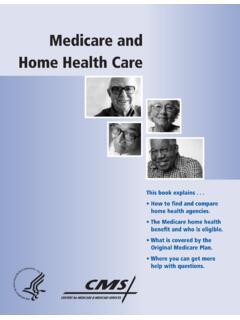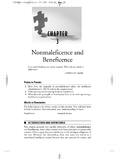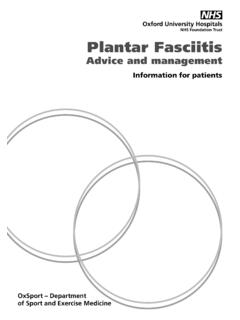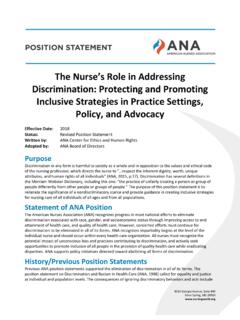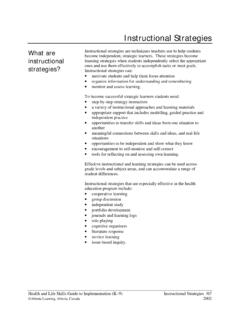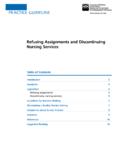Transcription of DEVELOPING PATIENT EDUCATION HANDOUTS
1 Thomas A. Lang DEVELOPING PATIENT EDUCATION HANDOUTS 1 DEVELOPING PATIENT EDUCATION HANDOUTS Thomas A. Lang Tom Lang Communications INTRODUCTION In recent years, patients have increasingly requested the opportunity to participate more fully in their medical care. An important part of responding to this request is the production of educational HANDOUTS that inform patients about health problems, describe medical treatments, and promote healthy behaviors. DEVELOPING effective PATIENT EDUCATION HANDOUTS is often difficult. Many caregivers have neither the time nor the training to write and design them. Even writers schooled in English or journalism may find that they are unprepared to write instructions that patients must understand thoroughly and follow closely and that may be read in several different circumstances.
2 Grammatically correct sentences are not enough; writers must be creative, flexible, and sensitive in their use of language, illustrations, and graphic design to address the variety of audiences and uses of such HANDOUTS . Conventional HANDOUTS usually record descriptive information about diseases or reiterate the advice given by caregivers. As such, they are useful extensions of spoken communication. However, increased understanding of how readers make sense of written texts, how notions of "reality" are created and maintained, and how behaviors can be influenced have resulted in the possibility that PATIENT EDUCATION HANDOUTS can be effective enough to be thought of as a form of what is being called bibliotherapy. To produce HANDOUTS that can be therapeutic in their own right, writers need to adapt a new orientation to their task, become familiar with a new body of knowledge, and master a new set of skills.
3 Thus, in this booklet I describe how to develop effective PATIENT EDUCATION HANDOUTS . (I've used the term "handout" here because I've limited the discussion to written , printed materials.) I discuss the qualities of effective HANDOUTS and present several techniques to enhance these qualities. I also suggest a series of tasks for producing HANDOUTS efficiently and for evaluating their effectiveness with patients . Thomas A. Lang DEVELOPING PATIENT EDUCATION HANDOUTS 2 Thomas A. Lang DEVELOPING PATIENT EDUCATION HANDOUTS 3 WHY ARE PATIENT EDUCATION HANDOUTS IMPORTANT? PATIENT EDUCATION HANDOUTS are important because: They are an extension of medical care and can affect its quality. The primary purpose of PATIENT EDUCATION HANDOUTS is to improve patients ' health and quality of life.
4 effective HANDOUTS should thus improve adherence to prescribed behaviors by changing or reinforcing patients ' knowledge, skills, values, or choices related to their health. Spoken messages are forgotten quickly and so need to be reinforced with informative HANDOUTS . The facts in a spoken message are quickly lost and reinterpreted. Well written HANDOUTS counter this loss and reinterpretation by reducing the need to remember spoken instructions and to guess at forgotten meanings. patients form opinions about their caregivers from PATIENT EDUCATION HANDOUTS . HANDOUTS communicate both a message (the instructions patients should follow) and a "meta-message:" how important the message and the patients are to the caregiver. Thus, well written , attractive HANDOUTS say, "This information is important to you [and by implication, so are you].
5 " The message and meta-message also have important marketing implications for the institution. WHAT MAKES effective HANDOUTS ? Well prepared HANDOUTS are: Easily accessible. Information can be made more accessible by including it on items patients already use regularly: calendars, bookmarkers, wallet-size reference cards, and so on. A handout whose only function is to inform patients may be easily put aside and forgotten; a handout with additional functions can keep the information close to its intended audience. Appropriate for patients ' needs. HANDOUTS should enable patients to respond to specific health needs by providing information that is necessary and sufficient to direct and to promote patients ' self-care. Also, many patients appreciate a list of additional readings on the topic.
6 Easily understood. Instructions that are easy to understand are more likely to be read and more likely to be followed. Compatible with the patients ' values and lifestyles. Insofar as possible, HANDOUTS should appeal to patients and not offend them. (The intent is not to spare patients from the truth but to avoid making the communication unnecessarily confrontational.) Thomas A. Lang DEVELOPING PATIENT EDUCATION HANDOUTS 4 Compatible with other information given to the PATIENT . HANDOUTS are most effective when they support and are supported by other forms of communication, such as one-on-one teaching, audiovisual programs, and other reading materials. Conflicting information confuses patients and is thus counterproductive. Easily remembered. Understanding is often not enough; patients may have to recall their instructions before they can follow them.
7 Easily referenced. Information that is not or cannot be remembered should be easy to find in the handout so that it can be read again when necessary. Visually appealing. Well designed and illustrated HANDOUTS enhance the above characteristics and impart the meta-message that the information they contain is important. Efficiently and economically prepared. HANDOUTS should be created through a process that results in a timely, well conceived, and quality product and that avoids unnecessary delays, confusion, and costs. WHAT CAN HANDOUTS ACCOMPLISH? Educational HANDOUTS are only a small part of the communication patients receive from health care providers. They compete with hundreds of other messages about health and illness and life-style choices, as well as with all the other messages encountered by patients every day.
8 In addition, the association between health knowledge and health behavior is poor. Thus, expectations about what HANDOUTS can accomplish need to be kept in perspective. HANDOUTS are not substitutes for health care services; they are generally not effective in the absence of other, "collateral" communication or behavior change strategies; and they are not effective in presenting all issues or all messages. They can, however, inform patients of important facts, instruct them in performing certain procedures, remind them of important behaviors, and help persuade them to adopt new health behaviors. The value of these functions can be high to both patients and caregivers. HANDOUTS are relatively inexpensive to produce, in both total and unit costs. Thus, even if only a few patients change their behavior as a result of a handout, the cost-benefits can be significant.
9 If a handout on colonoscopy can prevent a single PATIENT from coming to a medical center unprepared for the exam, which in turn prevents a delay in PATIENT care, an unnecessary trip for the PATIENT , an unfilled appointment time for a physician, the need to schedule another appointment, the need to take another day Thomas A. Lang DEVELOPING PATIENT EDUCATION HANDOUTS 5 off work, and the need to make another trip to the clinic, as well as all the associated emotional consequences of these events, the cost of the handout is undoubtedly worth it. HOW TO WRITE effective HANDOUTS To help readers accept the information in the handout, consider two general principles. First, be positive and encouraging. Help patients make the best of an unfortunate situation with supportive comments. Assure them that they are not alone and that their caregivers understand their concerns.
10 Second, take a "risk and rewards" approach rather than an "authoritarian" or "paternalistic" approach. Instead of telling patients to stop smoking, educate them about the health risks posed by smoking and tell them that these risks must be compared to the very real personal rewards that maintain the habit. Explaining the risks and rewards of health behaviors asks patients to make informed choices about their behaviors, rather than to follow orders; to be agents in their own care, rather than passive recipients; and to accept responsibility for their actions, rather than guilt or blame. Remember, too, that patients do not develop disease, diseases develop in patients . patients are human beings, not "by-passes" or "gall bladders" or "tonsillectomies." patients also do not "deny" having symptoms, they have not experienced them, and they do not "complain" of symptoms, they report having them.
